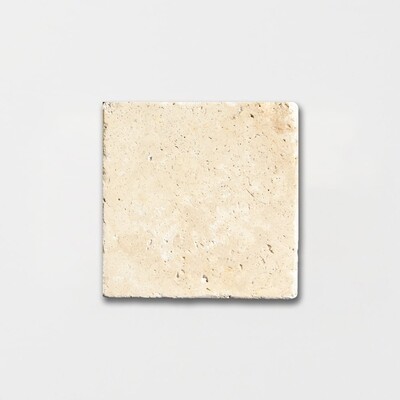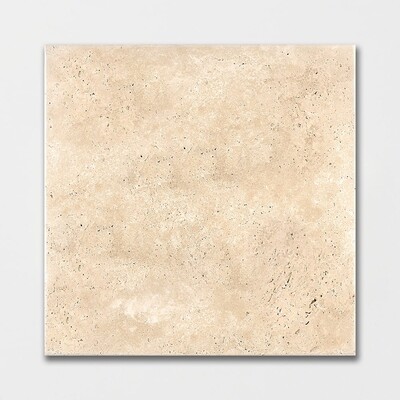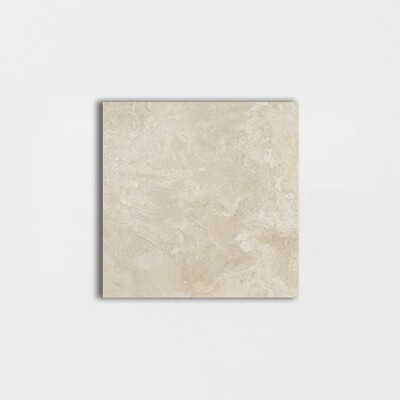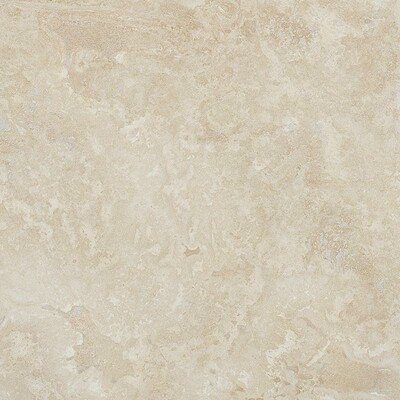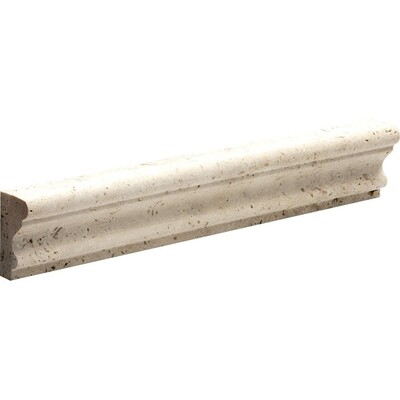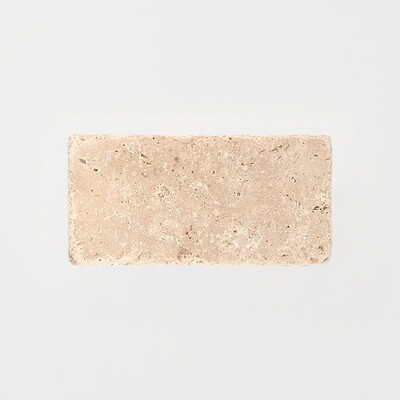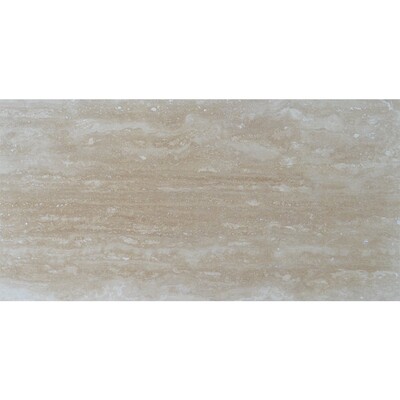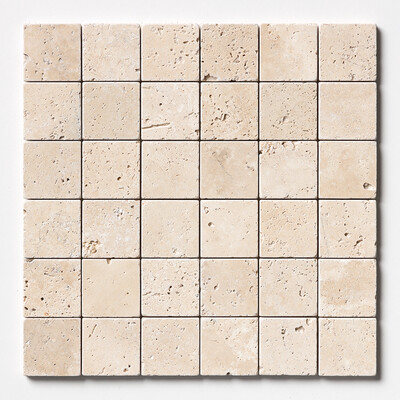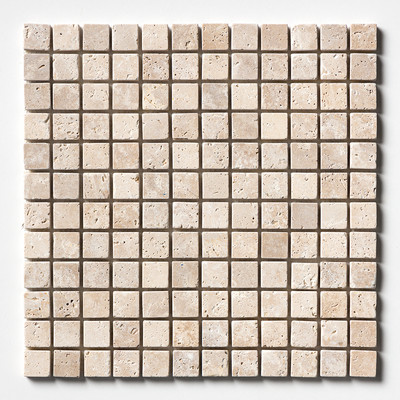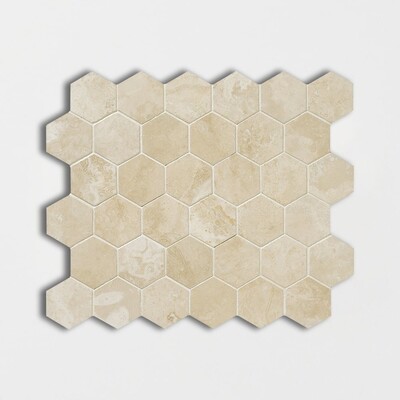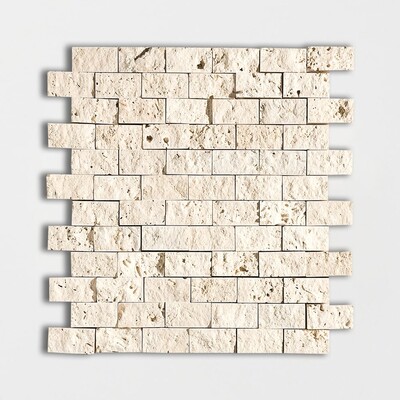1–20 of 68 results
Travertine tile is formed from limestone that develops in high temperatures. Travertine tile is most notably formed in hot water springs. These springs exist all around the world, so travertine tile has no specific place of origin. Travertine can be sourced from many locations from Italy to Iran, to Peru. In North America, the famous Yellowstone National Park is where a large portion of travertine is found.
All over the world, travertine tile is prized as a durable and elegant natural material. Travertine tile is used in commercial areas and has many residential applications. In homes, you can find travertine flooring, travertine countertops, and travertine on backsplashes. Homeowners also use this amazing tile for shower and tub surrounds, fireplace surrounds, and for outdoor pavers along walkways, patios, and swimming pools. Unlike materials like granite and marble, travertine has a naturally worn appeal suitable for both casual and formal decor.
Aside from its visual appeal, travertine tile has several key advantages. Travertine tile is a natural stone that boasts a rustic charm. The natural color variations of the tile make it a lovely addition to outdoor spaces. The look of the travertine applies to commercial and residential designs.
Additionally, travertine tile is an affordable option for those looking to have natural stone without breaking their budget for granite or marble tile. Using travertine instead of pricier stones will give you a high-class result within a more palatable price range.
Lastly, travertine tile comes in several luxurious finishes, so you can choose a tumbled travertine tile for an ultra-natural look, or go with a polished travertine tile that boats a smooth and shiny gleam.
Travertine does have a couple of slight disadvantages, which we have already touched upon. The major disadvantage to travertine lies in the fact that the material often requires more frequent sealing than other stones. Sealing is essential to keep travertine tile looking its best and reduce wear on the tile surface.
Travertine tile can be used in showers, however, it's not the most durable material for the space. Travertine tile is porous so constant exposure to water. Water from showers, sinks, etc., can wear down the surface of travertine tile over time. Even with a sealant applied, travertine tile can be affected by high water exposure. Outside of the shower, tumbled travertine tile floors can work beautifully if the tile is properly applied and sealed.
Travertine shower tile can be slippery when wet so it's not typically recommended for this area. The porous composition of travertine makes it more likely than other stones to break down from exposure to water.
If you notice that your travertine tile is turning black then you are not alone. All shades of travertine can darken slightly over time. Shades such as white travertine tile have an increased tendency to darken over time. As the iron compounds in the stone mix with oxygen, the reaction causes the tile to darken. Buildup from dirt can also stain light-colored travertine tile over time.
The time intervals for travertine depend on whether you have indoor travertine tile or outdoor travertine tile. If your tile is outdoors, it may need to be sealed every three or so years. Indoor travertine tiles can require a sealant every three to five years. High-traffic areas and frequent areas with high moisture exposure will need to be resealed more frequently.
Travertine tile does need to be sealed. While this tile is known to be durable, the truth is that it isn’t as water-resistant as other types of stone, such as granite. Travertine tiles should be sealed upon installation with either an enhancing or natural sealer. Then a new coat of sealer should be applied periodically, to help maintain the tile’s quality and luster.
The answer to this depends on the finish of your tile. Polished travertine tiles and honed travertine tiles can both be very slippery when wet. Textured finishes like sandblasted travertine and antiqued travertine tile (also known as tumbled travertine) offer more natural traction. However, they should still be used with caution.
Travertine tile is not known to crack easily. However, it is a natural stone with high moisture absorption. Therefore, water can erode the tile if it's not sealed with a protective coating. Travertine should be sealed more or less frequently depending on foot traffic, and moisture exposure which includes rain/snow/ice.
No, travertine tile is not hard to maintain. You can easily maintain travertine tile using a gentle cleanser, some warm water, and a soft mop or microfiber cloth. If you have installed travertine kitchen floors, travertine bathroom floors, or travertine tile backsplash, cleaning with gentle materials will keep your tile looking like new. Clean up any spills on the tile immediately to avoid staining.
Travertine tile is not as boldly veined as marble tile, and it's not as deeply hued as granite but it does offer lovely color options. Most travertine tiles will range from medium to warm-toned neutral shades. If you are in the market for a rustic home design we have several lovely options such as our Ivory Tumbled Travertine Mosaic, Ivory Honed Filled Travertine Mosaic, and our Ivory Honed Filled Hexagon Travertine Mosaic.
We have these exquisite styles and much more available for you to explore.
There’s a certain quiet luxury that comes with using travertine tile in your space. It’s not loud. It doesn’t need to be. This natural stone tile, formed deep beneath the earth over thousands of years, brings a sense of history and refinement that instantly grounds a room. From sun-drenched courtyards to modern bathrooms, its earthy tones and organic patterns feel timeless.
Designers turn to travertine not just for its beauty, but for its depth of character. Every piece tells a slightly different story—veins, pits, and textures that aren’t manufactured, but born of the natural world. At Country Floors, we’ve curated travertine tile collections that celebrate those variations, allowing each installation to feel both custom and deeply rooted.
It’s a question we hear often: What is travertine tile, and why has it been used for centuries? Technically, travertine is a form of limestone, created when mineral-rich water flows through underground hot springs. As that water evaporates, it leaves behind sediment that hardens into stone. The result? A porous, soft-textured material with rich variation in color, from pale ivory to silver, golden beige to earthy brown.
That natural formation process gives travertine its signature look—one that no two tiles can exactly replicate. It’s part of the appeal. There’s an honesty to it, a texture that feels lived-in from the moment it’s installed.
This stone doesn’t belong to any one style. It adapts. It complements traditional interiors with warmth and richness, yet holds its own in contemporary spaces through minimal finishes and soft, muted tones. Travertine tile is just as suited for sleek kitchens as it is for rustic floor tiles.
It can be polished for a smooth, reflective surface or left honed and filled for a matte, soft-touch finish. Each treatment reveals something different—sometimes understated, sometimes bold.
The finish you choose makes all the difference in how travertine tile lives in a space. Some finishes bring out their natural texture, others highlight their movement and patterning.
Installing travertine floor tile is about more than utility. It’s about creating a surface that invites movement and adds soul to a room. It feels warm underfoot, holds up beautifully in high-traffic areas, and carries a look that only improves with time.
There’s something undeniably calming about a travertine tile bathroom. The muted tones soften harsh lighting and help create an environment that feels restorative. Use it on walls, bathroom floor tiles, or even a custom vanity surround for a spa-inspired aesthetic that still feels organic.
Some materials feel like they belong outside, and travertine tile outdoor installations prove that. The stone’s natural porosity helps it stay cool underfoot, even on hot days. That makes it perfect for pool decks, patio tiles, or garden walkways where texture and safety matter just as much as beauty.
This might be where travertine tile feels most at home. Around a pool tile, it creates a grounded transition between water and stone. It's slip-resistant, gentle on bare feet, and its subtle color variations reflect the surrounding landscape beautifully.
Walls become more than walls when you add depth, movement, and natural variation. Travertine makes that transformation feel effortless.
Used vertically, travertine wall tile adds texture and dimension. It can take a simple powder room wall or fireplace surround and turn it into something sculptural and unexpected. The natural veining draws the eye, creating flow and visual rhythm.
There’s nothing quite like stepping into a shower lined with travertine shower tile. It absorbs light rather than bouncing it, creating a cocoon-like effect. Pair it with soft lighting and matte fixtures for a space that feels instantly calming.
A travertine tile backsplash isn’t just functional—it’s art. Its organic patterns act as a natural focal point behind stoves or natural stone sinks. And because travertine complements a range of countertop materials, from quartz to wood, it’s an easy choice for layered, lived-in design.
Think classic layout meets natural material. Travertine subway tile brings the structure of a traditional format with the unique texture of stone. It’s a subtle way to bring travertine into a space without overwhelming it.
With travertine mosaic tile, the stone’s finer details come to life. Smaller cuts showcase more contrast in tone and texture, making them ideal for accent borders, niche insets, or intricate shower floors.
One of the standout qualities of travertine tile is its earthy palette. These are the tones of sand, stone, and sun shades that bring ease and quiet sophistication to a space.
Classic and clean, beige travertine tile gives warmth without heaviness. It’s the kind of neutral that invites layering—textiles, wood tones, and metals all play well with it.
For those looking to make a stronger statement, brown travertine tile adds richness and depth. It anchors a space without darkening it, offering a more grounded aesthetic.
Sleek and cool, silver travertine tile feels modern but still organic. With subtle swirls of grey and white, it’s a striking choice for contemporary interiors or minimalist outdoor tile applications.
A question we hear often is how to clean travertine tile without damaging it. The answer? Keep it gentle. Avoid acidic cleaners, opt for a soft mop or cloth, and reseal periodically based on foot traffic. With the right care, travertine ages beautifully—gaining character without losing integrity.
There’s a tactile quality to travertine tile that just doesn’t come through on screen. That’s why stepping into our tile showroom near you can be so valuable. Seeing it in different lights, feeling the finish, and pairing it with other materials—that’s where the design process comes alive.
At Country Floors, we’re here to help you get hands-on with the material. From design consultation to sourcing the right finish for your space, our team is ready to guide you.

